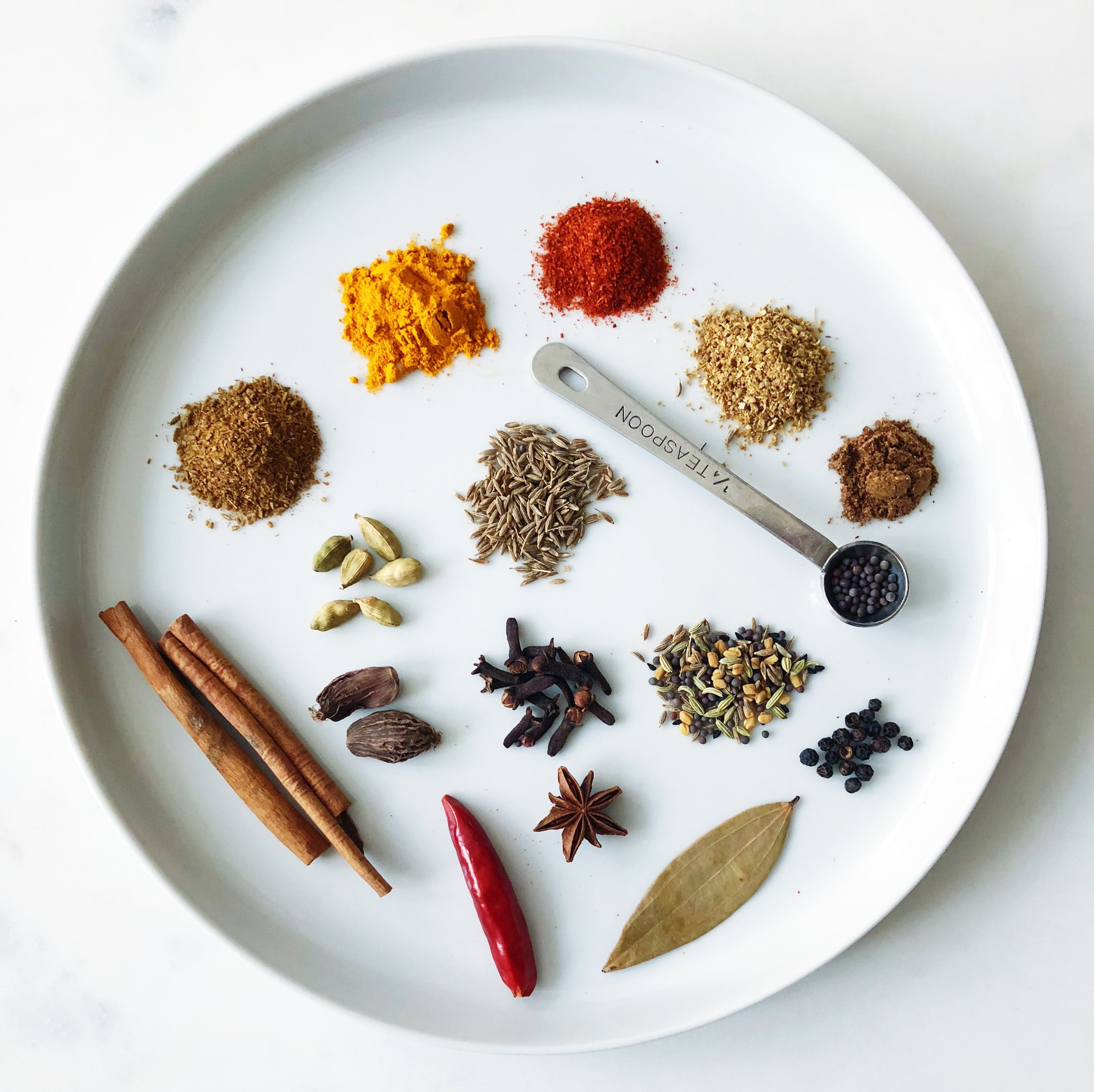Guide to Indian Spices
Welcome to the inaugural post of For Good Measure! Each month I'll be sharing at least one post with some tips or tutorials on the foundations of cooking. You can expect me waxing poetic about cooking techniques, specific ingredients, or kitchen tools. The ultimate goal is to share everything I have and am learning about great cooking. Given the theme of my blog, it only felt appropriate that the first post dive into sometimes overwhelming but always delicious world of Indian spices.
Now, before we go any further and you call the aunties on me, I want to make two things clear (1) this list of spices is not exhaustive and (2) you do not need to own all of these spices to cook delicious and authentic Indian food at home. There are even more spices in Indian cuisine than the fifteen I've documented here. With a country as diverse and history as old, Indian cooking has many shades. Personally, as a person of Indian heritage, preserving my culture through our food is important to me. You may want to dabble or you may want to dig deep - I've broken up my list of spices into three categories to make this suitable for both categories of home cooks.
I've alluded a few times to my insane spice cabinet, so I understand the annoyance of buying spices that you use only once or twice (I'm lookin' at you, za'atar). Whenever applicable, I've left notes about other cuisines or other ways to use these spices. Hopefully, you also like Mexican and Middle Eastern cooking because boy, do we share flavor profiles. Over time I'll be sharing many recipes, across cuisines and bastardizing flavors, using all of these spices.
On a final note, as I build up my cooking chops and this blog, I will be adding to this list, as well as linking to this page as a reference. Come often for the latest and greatest spice concoctions!
Level One: The Five Staples
When I moved out of my parents home and was missing mom's cooking, she got me started with these five staple spices. All of these spices are available in every grocery store or our overlords at Amazon.
- Turmeric powder: This is in every Indian spice tin, across the country. The bright yellow is what gives Indian curries their distinct hue. Turmeric also has some fantastic health benefits - it helps with inflammation and kills bacteria.
- Cumin seeds and powder: Cumin is multi-purpose, as it's a very common spice in Mexican, Middle Eastern, and North African cuisine. In Indian cooking, whole cumin seeds serve as aromatics and powdered cumin is in the spice base of most curries. It has a very earthy flavor and a little goes a long way.
- Coriander powder: Another staple Indian cooking shares with Mexican cooking, as well as Mediterranean cooking. It has a lemony and fresh flavor and is therefore often paired with the earthy cumin. The citrus notes open up a lot of possibilities as well - crust on fish, flavoring in dips, and much more.
- Tip: I buy mine whole, toast them for 1-2 mins on a warm pan, and grind them in smaller batches. The difference between grinding your own and store-bought is real, my friends!
- Cayenne pepper (aka chili powder in Indian stores): Indian food has a reputation for being spicy, so this, of course, is a staple.
- Garam masala: This is a ground mix of whole spices and can vary significantly from region to region, home to home. It is often added at the end of curries and just like that extra pinch of salt, can make all the difference. Most garam masala will have some cumin, coriander, black peppercorns, cinnamon stick, cloves, and nutmeg but again, it can vary quite a bit. For instance, North Indians will add the bold black cardamom and East Indians will add the sweeter fennel.
- Confession: All the garam masala I've ever used has either been made for me by my mother or it's been store bought. If you get into the second level of spices below, you can make your own. Until then, join me in laziness and buy it at any grocery store with an international aisle or your nearest Whole Foods/Amazon.
Level Two: Aromatics
These spices are often added whole to hot oil before anything else goes in. As my categorization suggests, they flavor the oil and add a lot of deep flavor during the cooking. These spices are especially used in meat dishes and are used to make garam masala.
- Cinnamon sticks: Sweet and earthy. You can also toast and grind these at home and use in any number of American desserts.
- Cloves: Spicy and earthy. Cloves are used to flavor oils, in garam masala, and sometimes in curries as well. This is a very strong spice and most recipes call for small quantities, so you do not need to purchase large amounts. Cloves are also common in Middle Eastern, Moroccan, and old-fashioned Christmas hams!
- Bay leaves: Fresh or dried, whatever is easier to find. They are a common addition to stews all over the world and Indian cuisine is no different.
- Star anise: The prettiest and likely the most expensive spice (typical, amirite?). Star anise has a strong licorice flavor, so I tend to use very small amounts to flavor oils. This is also a very common spice in Chinese cooking (one of the five ingredients in Chinese five spice) and part of all good pho broths. It also helps make a great mulled wine!
- Green cardamom: These little pods can be pricey but luckily, if you're cooking for 2-4 people, you're using no more than 2 pods at a time. Cardamom has a sweeter and refreshing flavor; aside from its presence in most meat curries, it's also a key part of Indian desserts. If you're a baker, the possibilities for all sorts of desserts, Indian or otherwise, are endless.
- Black cardamom: Black cardamom is the less delicate, more rugged cardamom. It's exclusively used in big bold curries and is very popular in North India. Again, a little goes a long way. Use smaller pods when cooking for 2-4 people and scale up accordingly.
- Black peppercorns: This is just black pepper, nothing fancy. The whole spices are used again used to flavor cooking oil and in garam masala. And you know what to do with the excess.
Level Three: Home Cooking
Okay, so you think you want to get into regional home cooking. Well, start with this short list and join me as I learn more about this list myself.
- Whole red chillis: Used to especially flavor dals or lentils. Smell the chilis before you buy them because you want the spicy kind; if it feels like you're going to sneeze, you've got a winner.
- Mustard seeds: Staple in Eastern and South Indian cooking but a relatively popular ingredient throughout the subcontinent. Mustard seeds are used whole or ground up into a paste, depending on the recipe. Like a good mustard on a sandwich, the real stuff is spicy and bold.
- Panch phoron (aka East Indian five spice): Made up of fenugreek seeds, nigella seeds, cumin seeds, mustard seeds, and fennel seeds in equal parts. You can buy all five of these individually and make your own but I just buy mine premade either online or at an Indian grocer, as this is harder to find than most other spices. The mix is used in many vegetable and fish dishes. In my opinion, the fennel is the real hero, as its sweetness is a perfect counter to four savory and earthy spices.
- I'm still figuring out what to do with fenugreek and nigella seeds so I, unfortunately, can't illuminate too much on two spices. Check back when I'm smarter.
- Ghee: Clarified butter. This is not a spice and nor is it pictured here but this stuff is a big part of Indian home cooking. Like with anything indulgent, you have to be mindful of how frequently you're eating ghee; add a teaspoon or two at the end to a pot of Indian lentils and taste the magic.







